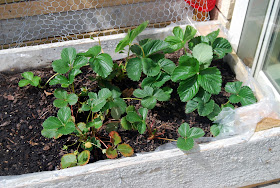Yes it is Easter, Easter and more Easter at our house...but most of all...HAPPY Easter to you all!
I hope you have a hot cross bun on the ready with a nice cuppa as you visit today:)
Above: Our table display, it's not much but I like it's simplicity.
Below: Easter Cupcakes!
To make these yourself mix and bake your preferred cupcake mix. When cool drizzle over melted white chocolate and place on top a Easter themed chocolate. I made the chocolates using choc molds. One thing I like about these is that by changing the colours and chocolates you can make these for adults of children without any extra expense or hassle.One batch two purposes!

You can see more of this Easter embellishment I made using recycled and scrap materials on my other blog if it takes your fancy!
When you teach at home you quickly learn to utilize all opportunities! I wanted a Easter decoration for the window and my son needed to review chemical change...add the two together and you have a burning/chemical change/products Easter egg!
Did you know carbon glows yellow when it is heated? The yellow part of a flame contains carbon, carbon dioxide and water. Grey in the flame is unburnt vapors and blue is complete burning with carbon dioxide and water present.
We produced black carbon (soot) by putting tin foil in the yellow part of the flame.
A change that produces new substances is called CHEMICAL CHANGE. The substance produced by chemical change is called a PRODUCT. In our case Carbon which we used to make these adorable and funny bunnies. Yes my son did put a bunnie in a pot and shoot one out of a canon....BOYS!
My daughter is studying the digestive system as part of her NCEA science course. Not to be left out she created a Easter Egg showing the break PEPSIN ENZYME breaking down PROTEIN MOLECULES.
Eventually the protein is broken down so small it can pass into the blood stream (as AMINO ACIDS)
Pepsin bunnies...check out Little Miss Cute Bunnie and Big Pepsin.
Smaller protein molecules...unfortunately I forgot to photograph the even smaller bunnies in orange!
Baby blue Amino Acid Bunnies, next to Too Dang Cute Bunnie from the protein stage...
Can you tell we had fun??
May your nest be blessed!
Lisa
Also linked to:
Share the Joy
Share the Joy









































